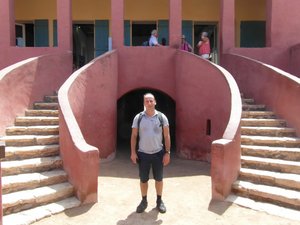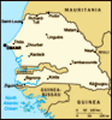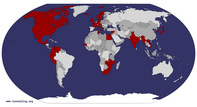Advertisement
Published: July 20th 2017

 Me
Me
Maison des Esclaves, Ile de GoreeDear All
Greetings from Dakar, capital of Senegal, and home to around 3 million of Senegal’s population of around 14 million. It also happens to sit on the westernmost point of Africa, on a small triangular-shaped peninsular which juts out from the African mainland into the Atlantic Ocean. It is a beautifully sited city, and this was evident from the stunning views seen from the aeroplane as we came into land on Tuesday evening – a city lit up by countless street lights, surrounded by an ocean of darkness all around. A beautiful arrival into my first port-of-call on my West African journey this year.
My prediction in my last blog entry was indeed correct – whilst Dakar is only a 4.5 hour flight from Europe, it could not be more different from comparative urban European peacefulness and street calm. This was first made clear to me by the frenetic and chaotic “queue”, or melange of people, which inevitably formed at passport control as my Iberia flight landed at Leopold Sedar Senghor International airport at the same time as a flight from France. It took about 40 minutes to make it through this, a veritable test of patience and
probably a sign of things to come, as I contemplated the sheer fairness which exists in a British queuing system – you clearly know who is in front of you, and who is behind you, and any infringement upon your personal space is met with a courteous smile or a huffed sigh. Here it was anyone’s game, and the Europeans (mostly French) were as good as the Africans in making sure they kept their position in the melange, or advanced it whenever possible. I found this quite stressful, but at least it was over fairly quickly, and I was able to have another stamp added to my rapidly-filling passport. From here, a short walk to the baggage collection point, where for once, in fact maybe the first time in my history of travelling, my backpack was already making its way around the carousel when I got there, and I didn’t spend the good part of 40 minutes or so wondering how my travels would be without my belongings… Ah, it’s the small things in life. From here, it was a short walk to customs where the three or four guards there on duty were too busy chatting to notice any
luggage going through their x-ray machine, and then a final walk into an abyss of local taxi drivers and general ne’er-do-wells that seem to congregate at airport arrival terminals all over the developing world. After a short walk of looking for my name on a sign, and being asked countless times by locals whether I wanted a taxi for a good price (this time in French, which is so far a new experience for me!), I couldn’t find my taxi driver who I’d booked to take me to my hotel. I dipped back into the airport terminal to make a quick (expensive) phone call on my UK phone to the hotel, to find out that he was there somewhere, so I braved the chaos again. Eventually I did find him, upon which he disappeared for five minutes to pay his parking fee, leaving me at the mercy of the taxi touts for what felt like much longer – it was a real relief when he returned, I nearly hugged him! It was then a very pleasant drive through the evening streets of Dakar to my wonderful hotel, the Hotel Oceanic, and my first port-of-call on this five-week African adventure.
I have enjoyed a wonderful two days here in Dakar, just familiarising myself with the local vibe and ways of doing things around here. I have gained the impression so far that Senegal is actually quite a developed, civilised corner of the African continent, which is certainly a pleasant surprise. Most people are cordial and polite, having adopted a French form of civility without the kind of arrogance demonstrated by a certain measure of the French population towards anyone who has anything less than an advanced knowledge of the French language. I have enjoyed practising my French so far, this is very much a Francophone country, and almost every tourist I have encountered (except two South Africans I met on a boat today) has been French. The streets are civil, in an African-sort-of-way. They are still quite loud, frenetic and chaotic, with no form of pavement system for pedestrians and teeming with all sorts of rubbish, but I have been thoroughly impressed by the courtesy of the drivers, who actually stop and allow you to cross in front of them – this is something I have rarely seen on my travels. There are, on the downside, a very noticeable number

 Hotel Oceanic
Hotel Oceanic
Dakar, Senegalof street hustlers and hawkers, who only seem to get the message that you’re not interested in their products or services after around three or four polite “no’s” or tactical ignorance. Still, they are nowhere near as bad as those I have encountered in the tourist spots of Egypt, most notably Luxor, and I hear that they mainly congregate in Dakar, so I am hoping that other parts of the country may be a bit more hassle-free.
So yesterday I just spent the day exploring the central area of Dakar known as Plateau, walking around its grid-square-planned streets, former French colonial buildings, and all sorts of shops and market stalls. This included a visit to the city’s central square, the Place de l’independence, the Presidential Palace (where you’re not allowed to stop, nor take photos, just keep walking past it), the Musee Theodore Monod, with its extensive and very interesting collection of African masks and art, and the Catholic Cathedrale du Souvenir Africain.
Today was a really very pleasant and enjoyable day also, though incredibly hot – I have seriously caught the sun, and had to do a double-take of myself in the mirror just now seeing the

 Hotel Oceanic
Hotel Oceanic
Dakar, Senegaldifference between my browned arms and the rest of the skin which my t-shirt was covering for the day – I have darkened considerably since the last time I looked in the mirror this morning! I took the local ferry to nearby Ile de Goree, a tiny island around 3km off the shore of Dakar city, which once served as the second most important French colonial outpost in French West Africa, after Saint Louis to the north. The island is only around 600m long by about 300m wide, but is packed with beautifully cobbled streets and old French colonial buildings, draped in bougainvillea and other exotic plants. Although it was quite touristy, with a fair number of hustlers also at the ferry dock, I spent a wonderful four hours there just wandering the streets, and enjoying the sea air. The island is also home to the more sobering experience of the Maison des Esclaves. It is believed that not many African people were sold and traded as slaves on the island, but that it was still one of the most important political and economic centres of the slave trade. This was a very sombre experience, and probably one of the

 Hotel Oceanic
Hotel Oceanic
Dakar, Senegalmost important narratives encountered on a journey anywhere in West Africa. The house was typical of its day, the first floor housing the wealthy European traders, whilst the basements below give way to the cells and dungeons where the poor local people were kept in terrible, cramped conditions before making the one-way journey across the Atlantic. There were cells for different types of people, most sad to see were the “enfants”, where presumably the children were kept. Also of note was the “door of no return”, which although no slaves were likely to have passed through this, it was a door opening out from the dungeons to the ocean, symbolic of the one-way journey which lay ahead of most people unfortunate to have spent time there. The nearby Historical Museum housed in the island’s Fort d’Estrees had more detail and information on the African slave trade as part of Senegal’s history, and has compelled me to want to watch the film “Amistad” upon my return to England. I was particularly shocked to see the brutally cramped conditions the slaves were kept in on the boats which crossed the Atlantic, a picture showing prisoners clamped together in irons, and lying down
head to toe, all the way along the whole floor of a boat. Apparently only half of the people survived the crossing itself, the other half doomed to a life of slavery thousands of miles from their homes and loved ones. It was indeed, as mentioned, a sobering experience.
Aside from this, there was certainly peace to be found on the beautiful island, and many many local people enjoying a dip in the sea and a day at the beach.
I am now back in my air-conditioned, very comfortable hotel room. Whilst the room itself isn’t too spectacular, the Hotel Oceanic can be classified as one of my favourite types of hotels: the “faded colonial grandeur” type. The building was built in 1906, and the manager was inclined to tell me yesterday that in all of its years of existence, it has always functioned as a hotel. It even housed the doctor, whose name I forget, who developed the vaccination against the tsetse virus. I am also quite impressed with my French, as I found all this out, and most of my communications here so far, have been in French :0) I still need to find out what
“Pamplemousse” is, it rings bells from my schoolboy French days… The hotel today is dripping with history and old colonial-style touches, such as balconies attached to every room and French shutters, a very pleasant place to stay indeed.
Tomorrow my travels begin in earnest, when I somehow make my way down south to a village called Toubacouta, one of the many gateways to Senegal’s UNESCO-listed National Park, the Sine-Saloum Delta. I believe I need to take what locals refer to as “bush-taxis”, or “sept-places”, which seem to be the fill-up-and-go type of taxis one finds in so many countries like this, one step up from a bus with people hanging out the doors and off the back. I am hoping that there’ll be one going directly, but if not, I will probably need to change bush-taxi in a city called “Kaolack”, dubbed “Faolack” by English-speakers due to its, well, not-so-pleasant nature apparently. I shall of course update and write my next entry again in due course.
This has been a wonderful insight into the region, and start to my trip, and I have gained a very positive impression of this country and its people. I look forward now
to properly beginning the travelling part itself, the very word “bush-taxi” conjuring up all manner of images of travelling in Africa. I will of course write up my next blog entry again soon, after further adventures have been had.
In the meantime, hoping all is well with everyone, and saying “a bientot” for now :0)
All the best
Alex
PS Ah, “grapefruit” – thank you Google Translate :0)
Advertisement
Tot: 0.059s; Tpl: 0.015s; cc: 16; qc: 29; dbt: 0.0283s; 1; m:domysql w:travelblog (10.17.0.13); sld: 1;
; mem: 1.2mb























